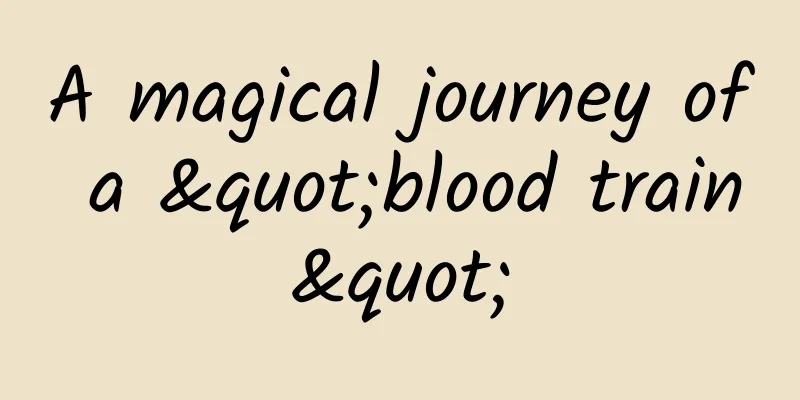A magical journey of a "blood train"

|
Why is blood red? Does donating blood affect your health? Why do people get leukemia? On May 13, with these questions in mind, we boarded the "Blood" train. Led by the "train conductor", Chen Aili, an associate researcher at the Beijing Institute of Genomics, Chinese Academy of Sciences (National Center for Bioinformatics), we traveled along the "blood vessel line" track, embarking on a magical journey of blood cells. "As a whole, the human body's various systems, organs and tissues require nutrients and oxygen at all times, and continuously produce waste such as carbon dioxide. The carrier for transporting these substances in the human body is blood, and the channel is blood vessels," said Chen Aili. If blood is compared to a train, then blood vessels are the intricate railway network. Click, click, the train starts moving! The extensive railway network plays a crucial role. Whether it is transporting oxygen and nutrients or metabolic waste, the "blood train" needs to be transported to various parts of the body. On the railway network, the scenery along the way is really nice. Along different arteries or veins, you will see a variety of organs: brain, stomach, intestines, lungs... They all need oxygen and nutrients transported by the "blood train" to ensure good health. The "blood train" is always running low on power, and occasionally it stops at the big "pump station" of the heart to refuel, and then starts a new journey. How long is the railway network? "Blood vessels are also the longest organs in the human body, consisting of arteries, veins and capillaries, with a total of 100 billion, and a total length of about 100,000 kilometers," said Chen Aili. What does this mean? The length of the "blood vessel line" track can circle the earth two and a half times. Regarding the composition of the train carriages, Chen Aili explained that the "Blood Train" is composed of 55% plasma and 45% blood cells. The total blood volume of a normal person accounts for about 8% of body weight. It should be noted that once the blood loss exceeds 20% of the total blood volume, the train will face serious failures and even endanger life. According to my country's "Blood Donation Law", a healthy citizen can donate blood for free between 200-400ml, so blood donation has no effect on health. Blood cells that play such an important role are composed of red blood cells, white blood cells, and platelets. Each part has its own function to safeguard your health. Along the way, red blood cells are like tireless "couriers" with many super powers. They are responsible for transporting oxygen to various parts of the body and carbon dioxide to the lungs. They are rich in hemoglobin, so their color is red. There are many types of white blood cells, including neutrophils, eosinophils, basophils, monocytes, and lymphocytes. They are like the "train police" of this train, maintaining order in the train impartially and eliminating all suspicious elements. In the process, the white blood cells that heroically sacrifice will gather into large abscesses. Platelets are like the "maintenance workers" of the train. Although they are the smallest cells in the human body, they can help us stop bleeding and accelerate coagulation. Once the train breaks down, they will always be the first to appear and repair the damaged parts. △Under the guidance of the teacher, the children are conducting a small scientific experiment on "Potatoes agglutinate blood cells". As the train continued to move forward, different blood types also came to greet us. Blood type A: I am careful and thoughtful Blood type B: I am straightforward Blood type AB: I am a genius Blood type O: I am an optimistic, hard-working doer "Blood type generally refers to red blood cell antigens. Humans have discovered 44 blood type systems, but they actually don't have that much impact on personality. Currently, the most common are the ABO blood type system and the Rh blood type system." Chen Aili said that when doctors give blood transfusions to patients, they consider the consistency of red blood cell antigens; but when there is a need for a transplant, the matching of white blood cells must be the basis. When our bodies are healthy, the train runs smoothly. But if the train suddenly brakes, it means that our bodies are in danger. Leukemia, which people are afraid of, is one of the factors that affect the safety of train operation. Why do people get leukemia? Chen Aili explained that leukemia is a clonal blood disease caused by abnormal hematopoietic stem cells. In short, the hematopoietic stem cells are sick and no longer differentiate into blood cells that can work normally. Instead, they produce many inactive cells, causing train failures. In 1827, the world's first suspected leukemia patient was discovered. Twenty years later, in 1847, a German pathologist first proposed the concept of "leukemia" because he found that the white blood cells of such patients increased significantly. But in fact, the blood of leukemia patients is still red. For more than 100 years, in order to ensure the normal operation of the "blood train", the medical community has conducted extensive and in-depth research on leukemia, turning it from an incurable disease into a "curable" disease. For example, in 1975, doctors used bone marrow transplantation to treat leukemia for the first time; in 2001, targeted drugs were used for the first time in the diagnosis and treatment of leukemia. Here we have to mention a magic bullet for curing tumors - imatinib. Thanks to the efforts of medical experts, it is used to treat chronic myeloid leukemia (CML), which is common in adult leukemia patients, and the survival rate of the disease has increased from 50% to 95%. Chinese scientists have also made outstanding contributions to the treatment of leukemia, such as proposing a standard treatment for promyelocytic leukemia (APL) and the "Beijing Plan" for hematopoietic stem cell transplantation. However, up to now, there are still many subtypes of leukemia that have not been conquered. Many scientists are working hard to overcome the difficulties of leukemia. With the development of medical research, I believe that one day humans will eventually defeat leukemia. |
<<: How do fireflies glow? Are they charged in advance?
Recommend
Profits halved to give way to Midea, Dong Mingzhu, who had been pushing for Gree's diversification, failed again in the face of single-mindedness
Gree has not had a good time recently, at least a...
I was so surprised! The spring delicacies hidden in ancient poems
Spring is the season for tasting fresh food. Fres...
How did you come up with the title? 7 steps, from conception to hit product!
How did you come up with the title ? Do you recei...
Due to the continued high temperature, many hairy crabs did not survive...
Author: Fluent The highest temperature this week ...
Nutritionist's special reminder! Zibo barbecue is delicious, but you need to follow these 8 points to eat it healthily!
As the weather warms up, the barbecue industry ha...
Android device shutdown hijacking software appears in China
[[127995]] Antivirus company AVG recently discove...
To do live streaming sales, you need to master 6 marketing skills
What are the key points that companies need to hi...
NVIDIA GTX950 graphics card is competing with GTX980Ti, trying to compete with the gods?
NVIDIA GTX900 series graphics card family has bee...
Why is it so bitter when you take a bite of cucumber? That's the cucumber crying for help!
Some cucumbers are very sweet when you take a bit...
After three changes of jobs, this "Internet porn star" finally found out his last name
In early spring in Guangzhou, you can see beautif...
What is server hosting?
What is server hosting? In general, server rental...
Decrypting “User Uninstall”! 3 data points worth paying attention to!
Do you want users to use your app for a long time...
"WeChat finally supports multiple devices online at the same time" is on the hot search, but netizens are still dissatisfied: they want more
As a social APP under Tencent with more than 1 bi...
Xiaomi's mobile phone product marketing director confirmed that it will enter the Japanese smartphone market in 2020
Recently, Japanese media revealed that Xiaomi wil...
How to build a private domain traffic matrix to acquire a large number of customers?
The author and a good friend from a ToB company t...









